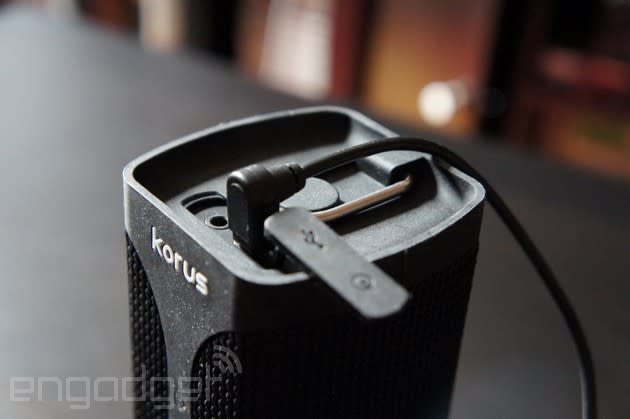IRL: The M20 speaker isn't enough to make you choose Korus over Sonos

Back in 2013, I got to try out the Korus system of speakers, the V600 and the V400, and was impressed by their ease of use and audio quality. The one thing that was lacking was portability; even though the V600 can use six D-cell batteries and comes with a handle, I'm not exactly going to stroll around town with it on my shoulder. Enter the M20, a small speaker that not only hooks into the Korus system via SKAA, but can also connect to other devices via Bluetooth, squaring it against the glut of portable Bluetooth speakers already on the market.
Korus likes to size its system up against the juggernaut that is Sonos, so it initially feels like the M20 is meant as a response to the relatively diminutive Sonos Play:1. But out of the box, it doesn't feel like an even comparison: The M20 is skinnier and taller, with a design aimed toward taking it out and about instead of just using it at home as part of a larger system. It's a long, black, squared-off cylinder with a metal ring on top. Am I meant to hang this from something? It's certainly slender enough to fit into the bottle holder on your bike, but the 7-inch height makes it a bit awkward to clip on your backpack. The outside has a rubberized feel, making it feel pretty durable. The downside is that it collects dust easily and no amount of blowing or wiping will make it look pristine again.

I settled for simply resting it on a table, plugging it in to charge via the included micro-USB cord very helpfully crooked at a right angle so it doesn't jut out so much on top. Since I already had the V600 and V400 set up in other rooms, adding in the M20 was a simple process. Korus speakers connect to "batons," which are dongles that you plug into whatever device you want to listen to. Last time, the company only had batons for USB, Lightning and 30-pin connectors. Since then, it's added Android compatibility, with a baton that plugs directly into a micro-USB port. I opted to start by connecting to the USB baton already plugged into my laptop, since I like to listen to music while I work.
As with the V600 and V400, the connection was seamless and instantaneous. But I can't say the sound quality of the M20 was up to par with the other speakers -- not even close. Given its size and intended usage, some drop-off was expected, but the difference was dramatic. The M20 was plenty loud and maybe a bit punchy, and while it sounded pretty fair on someone like Sam Smith, rock artists like Arcade Fire sounded tinny and distorted at higher volumes. On its own, it wasn't terrible: It can be perfectly acceptable on outdoor excursions, but you probably wouldn't want to include the M20 as part of a Korus "whole home" system. I had the V400 in my kitchen, the M20 in my living room and the V600 in my office, and as I walked through the house, I found the living room experience greatly unsatisfying. There may be a size difference between the V600 and the V400, but while the larger V600 is definitely more resonant, the smaller V400 still delivers pleasing sound. The M20 wasn't always pleasant, and when I had the other speakers running, I had to resist the urge to turn the M20 off.

If I could turn it off. That was my other problem with the M20. There's a clearly marked power button on the front, and pushing it turns the speaker on. But, though pushing the button should turn it off, that doesn't always work for me. I tried a quick tap and I tried holding it down for a few seconds, but it didn't respond to my presses consistently. My boyfriend seems to have figured out how to turn it off, but I still haven't found the secret sauce to get it to respond every time.
After playing some tracks off different audio sources -- including the Android baton and a second USB baton plugged into a different laptop -- I put the M20 aside and went back to the V600. But, even after tapping the button to switch audio sources back to the first USB baton, no sound was coming out of the V600. I pressed the button repeatedly, waiting for the music to kick in, but nothing came out. When no manner of button pushing seemed to help, I consulted the documentation included with the speakers (comprised of a "Getting Started" guide and a user's manual) to see if it offered a solution, but the majority of the help it could provide was limited to setting up the system and switching between audio sources. I even tried factory-resetting the V600 and reconnecting that particular baton, but no dice -- it wasn't connecting at all. The owner's manual referred me to the company's website for additional help, but Korus' web documentation was even less helpful.
I ended up switching to the second USB baton, which worked just fine, so the issue didn't seem to be Korus' USB driver. After a month or more, I tried the first baton again, and it seemed to be working, with no indication there was ever a problem.
I still really enjoy the Korus speakers for their sound quality and ease of setup, but that ease comes at a price in making it hard to diagnose problems that come up. I've had issues with Sonos from time to time too, but at least those kinks were fairly easy to diagnose and correct. Couple that with the M20's audio quality, which presents no threat to the Play:1, and it seems that Korus has quite a few areas where it needs to improve if it wants to truly compete with Sonos.








